Turquoise
A hydrous copper-aluminium-phosphate. By isomorphous replacement iron (Fe3+) can substitute for the aluminium, so the composition varies to some extent
Turquoise shop
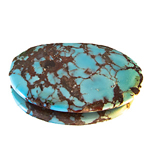
Antique Persian Turquoise with matrix and Pyrite inclusions
Origin of name: from the french word turquoise for "turkish", because Persian and probably also Egyptian (Sinai Peninsula) entered Europe by way of Turkey, were the gem was traded briskly.
Synonyms and trade names: none
Up to the 19th century the name Cal(l)aite was used occasionally.
This term derives from the Greek word καλάϊνος kalláïnos, meaning something like pale blue. Pliny the elder used this name in his monumental Naturalis historia.
Can be confused with: Chrysocolla, Variszite and Faustite (a zinc-aluminium-phosphate mineral also belonging to the turquoise group).
Turquoise is mainly confused with a plethora of imitations, dyed Howlite and Magnesite being the most common.
Besides, there is a range of pressed, sintered and glued Imitations made from various copper and aluminium components.Two rather well-known examples are "Viennese Turquoise" and "Neolith".
In the 1970ies the French company of Pierre Gilson introduced what they called synthetic turquoise. However, the chemical composition differed from the real McCoy due to the binder which they used. Thus "imitation" is more appropriate.
Be that as it may, Gilson´s turquoise was rather a headache as it was not easy to identify. It came in at least two shades of blue, with or without matrix and was traded under (in-house) names like Cleopatra and Farah.
Localities: the best Turquoise still comes from Nishapur, today Neyshabur or Neyshabour, a city in Razavi-Chorasan province,Iran.

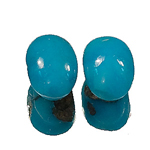

Persian Turquoise of fine colour and without matrix (on the upper side)
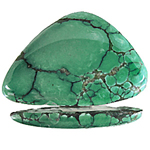
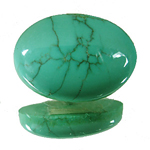
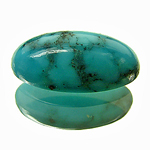
Green and bluish-green Turquoise with matrix
Other important localities are in the USA, particularly in Arizona, California, Nevada, Colorado and New Mexico.
Apart from the above-mentioned Iran and USA. only China is of some commercial importance (out of a total of 493 localities listed on mindat.org, ).
Handling: Turquoise is porous. To protect it´s surface and improve wearability, it is routinely treated with oil, wax, (synthetic) resin and even plastics (polystyrene).
Nevertheless it should be worn with care. Sweat, all kinds of brines (soap, shampoo, detergent), cosmetics, hairspray, cremes, lotions, perfume etc can all ruin the colour.
Turquoise is sensitive to heat. Be very careful during soldering or polishing. High temperatures can cause colour-change and dehydration, as does prolonged exposure to direct sunlight.
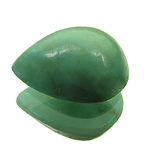
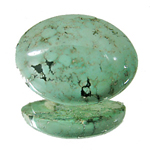
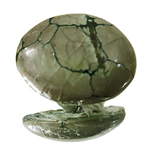
Deteriorated colour and dehydration in Turquoise
Worth knowing: Turquoise is amongst the oldest gems used by man and was very populare with the ancient Egyptians and the Aztecs, alike.
The Egyptians were the first to produce Turquoise imitations from glass, fayence and emaille.
Turquoise shop
 Deutsch
Deutsch